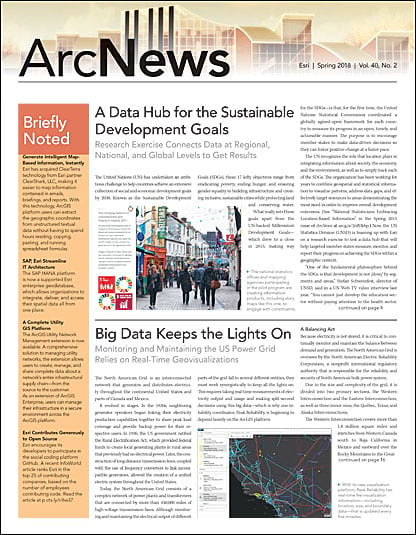Managing GIS: A column from members of the Urban and Regional Information Systems Association
At some point, everyone looks for a job, whether straight out of college or partway through a career, voluntarily or involuntarily. In standard hiring practices, all job applicants have to submit a résumé—through a human resources department, a colleague, or even a friend.
This résumé is a job candidate’s one shot at making a first impression. The right one can land someone a job interview. The wrong one can put anyone straight into the “no” pile.
So what makes a strong résumé? For starters, résumés need to highlight accomplishments, not previous responsibilities. To ensure that your résumé actually does this, here are some tips I have compiled after sifting through countless résumés over the years.
It’s About Accomplishments, Not Responsibilities
Aside from general errors and avoidable typos (I had someone misspell SQL once), most people are making one glaring mistake on their résumés: they aren’t telling hiring managers what they have actually accomplished in their careers.
Accomplishments are different from responsibilities. Responsibilities are the tasks and activities that someone was hired to do; anyone hired for that position could list out their job responsibilities. Accomplishments, however, are the results of effectively carrying out those responsibilities; only people who execute a job well could put accomplishments down on their résumés.
The most straightforward way to present accomplishments is by having a series of bullet points underneath each job subheading that highlight what you achieved. This shows hiring managers that you have done most, if not all, the tasks required to perform well in the role they are hiring for.
How to Change Course
There’s a simple way to turn a responsibilities-oriented résumé into an accomplishments-oriented one. It requires a simple, two-step process.
First, underneath one of your previous job titles, write a brief, one-to-two-sentence paragraph that explains what you were hired to do. Second, in a subsequent set of bullet points, list out what you actually achieved in relation to these responsibilities. Then do that for every single job on your résumé.
To illustrate how this works, here’s an example. In their current positions, Sandra and Bob both work on data conversion projects. Sadly, Bob is often behind schedule, has to continually fix errors, and never tries to figure out how to improve the process. Sandra, on the other hand, always converts her files quickly and accurately. She figured out how to automate the conversion process and improved production procedures. In fact, Bob started using Sandra’s script for his conversions.
Both Sandra and Bob could write the following bullet points on their résumés:
- Converted CAD and PDF files
- Proficient in ArcMap and Python
Those are responsibilities, though. Both Sandra and Bob are asked to convert files in their day-to-day jobs and can do at least some work in ArcMap and Python. And using a word like “proficient” when trying to illustrate skill sets doesn’t demonstrate actual knowledge or aptitude.
If Sandra were to list what she’s actually accomplished in both capacities, she would set herself apart from Bob. Here’s how:
- Increased data conversions 17% by developing custom Python script using ArcPy and ArcMap 10.5
- Converted 1,000 CAD and PDF files with no data errors by implementing a comprehensive QA/QC process
- Increased project profitability $10,000 by streamlining production process and coordination
- Reduced project delivery time frame by engaging client regarding data delivery issues
Bullet points like these go above and beyond the bare minimum and show Sandra’s accomplishments. They highlight not only what she does at her current job but also the results she’s achieved by doing good work.
Hiring managers want to see how candidates have added value to their organizations so they can assess whether applicants can do the same in the role they’re hiring for. Saying, “Used ArcGIS Online” is okay, but putting, “Made 20 apps using ArcGIS Online,” is a bit more telling. And writing, “Increased public awareness of municipal permitting applications by building 20 ArcGIS Online apps” is even better.

Verb, Result, Action
To write powerful accomplishment bullet points, they need to be put into a verb-result-action format.
First, start with a powerful verb such as Improved, Increased, Reduced, Delivered, Developed, or Implemented. Avoid less definitive verbs like Supported, Assisted, Helped, Learned, Tackled, and Pursued. These undescriptive verbs are vague and leave too much room for interpretation. When I see that someone supported a project, for instance, I wonder if he engaged clients and drove the process forward or just answered phones all day. I can’t know for sure, so I may assume the worst—otherwise, the candidate would have told me if he had actually done more.
Next, note what resulted from the action. What was the great outcome? Whenever possible, use metrics to add more weight. Here are a few questions to ask to get started on this:
- Why did I do the project?
- What was the final product?
- Was there an efficiency or financial gain?
- Did I reduce cost or turnaround time?
Answering those questions should elicit verb-result phrasing like the following:
- Increased production capacity 20%…
- Developed 40 maps and apps monthly…
- Reduced delivery time by 90%…
- Implemented a $50,000 project on time and under budget…
Finally, the action portion of a bullet point addresses how the result was accomplished—i.e., which software, technology, skills, and other tools you used to get those outcomes. Some samples include the following:
- …by implementing ArcGIS Enterprise
- …using .NET, HTML5, and custom web services
- …through researching available technology and making informed recommendations
- …using Microsoft Project Gantt charts
It helps to transition between the result and action part of each bullet point with the words using, through, or by.
The One-Page Conundrum
Job applicants should load up their résumés with as many accomplishments as possible. But doing that can make layout challenging, especially because every résumé—yes, even ones that chronicle 20-year careers—should fit on one page.
Large headings, lots of white space, and long sentences all eat up valuable space on a résumé. Adjust the margins, shrink the fonts, and reduce line spacing to make more room for accomplishments. Keep contact information to two lines. The longer you’ve been out of school, the shorter your education section can be. As you get further along in your career, one line per degree should suffice. Until then, treat your education as you would a job entry, complete with accomplishment-oriented bullet points.
Finally, make sure no bullet point exceeds one line. Being concise ensures that each statement packs power. More importantly, this gives you more room to add additional accomplishments. If you end up with more bullet points than you can fit onto one page, great! Pick and choose from your long list of accomplishments and tailor each résumé you send out to the job you’re applying for. Then save all the extra bullet points for a job application where they’re a better fit.
Start Now
Hiring managers must make quick decisions on job applicants’ capabilities, and all they have to base those decisions on is the information each candidate gives them. Having powerful, effective accomplishments on your résumé will help yours stand out when applying for your next job.
Putting together a good résumé takes time and a lot of hard work. If you start updating yours now, it will ideally be ready long before you need it. And if you commit to refining your accomplishment bullet points every three to four months, you will always have your entire career well documented.
So dust off that old résumé and start compiling a new and improved one today!
Read other articles in the Managing GIS series.
About the Author
Chris Akin, GISP, is the GIS manager at Dunaway Associates and the owner of GIS Resumes, a firm that offers GIS job applicants with help crafting résumés and cover letters. Akin has almost two decades of experience in developing and managing geospatial projects, strategies, and processes and is dedicated to helping GIS professionals achieve their career goals. He is a former member of the board of directors of the Urban and Regional Information Systems Association (URISA), the former president of the New England URISA chapter, and the current president of URISA Texas. Follow Akin on LinkedIn and on Twitter as @ChrisAkin98.


